
It’s 126 years since the famous Iron Lady was inaugurated in time for the 1889 World Fair in Paris.
It is now one of the most visited monuments in the world and around seven million people climb its stairs or take the lift to one of its three levels each year.
But it’s worth remembering that it was not always this popular. When construction began in July 1887, a group of around 300 artists, sculptors and architects sent a petition to the commissioner of the Paris exhibition demanding that he halt construction of the “ridiculous tower”.
Here are 12 facts about the Eiffel Tower:
1. Two years, two months and five days – That’s how long it took to build the Eiffel Tower, with construction beginning in 1887.
2. 7,799,401.31 – That’s what it cost in French gold Francs to build the monument.
3. 324 metres – That’s the height of the Eiffel Tower, including the antenna at the top. That works out at 1,063 feet. Without the antenna it is 300 metres tall (984 feet).
4. Six inches – That’s how much the tower grows in the sun. Yes the Eiffel Tower grows when it gets hot and shrinks in the cold. Although this is fairly hard to see with the naked eye.
5. 10,000 tonnes – That’s how much the Iron Lady weighs.
6. 20 years – That’s how long the Eiffel Tower was originally designed to last. It was built by Gustave Eiffel to commemorate the French Revolution and show off France’s industrial might. The removal men were meant to pull it down after 20 years, but Eiffel appears to have persuaded them to have a change of heart. The fact that the tower could be used as a wireless telegraph transmitter, made it fairly useful and saved it from the wrecking ball.
7. 103,000 kilometres – That’s the distance one lift travels each year, according the site livescience.com, which, to put into perspective is two and a half times the circumference of the earth. There are steps up to the top – 1,710 of them – but visitors can only walk up to the first floor.
8. 18 – That’s the number of times the iron lady has been repainted over the years. It takes a mammoth 60 tonnes of paint to give it a first coat.
9. 41 years – That’s how long the Eiffel Tower was the world’s tallest building for, before the Chrysler Building in New York came along and stole its mantle.
10. 250 million – That’s the number of people who have paid a visit to the Eiffel Tower over the years.
11. 1944 – The year when the Eiffel Tower could have been pulled down. Hitler ordered the German military governor of France to tear it down but he refused.
12. Six to seven metres – This is the amount the Eiffel Tower sways in the wind.











